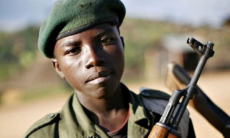
Email: ZYVC057@live.rhul.ac.uk
Total Article : 213
About Me:I'm a graduate student studying International Criminal Law and first started writing for King's News almost 4 years ago! My hobbies include reading, travelling and charity work. I cover many categories but my favourite articles to write are about mysteries of the ancient world, interesting places to visit, the Italian language and animals!

Both international and regional norms set out to protect civilians by prosecuting criminals and protecting the innocent, however, the categories of victim and culprit seem to merge when considering the role of child soldiers in armed conflict. Deciding whether children, who are being forced against their will to commit war crimes, can be held accountable for their crimes is a challenge which has led to a somewhat binary system of literature in which scholars endeavour to either argue for or against the prosecution of child soldiers.
One of the troubling things about studying child soldiers is that we don’t have much certain data on how many child soldiers there are or why they become active actors in wars. This makes the judicial process one of high complexity. Whilst Article 38 of the UN Convention on the Right of the Child strictly prohibits the recruitment of child soldiers , the data we have on the circumstances child soldiers face daily is quite ambiguous due to the difficulties of monitoring each child. It is estimated that approximately 300,000 children worldwide are soldiers - but not all take part in active combat as some take on the roles of chefs and spies - and anywhere from 30% to 40% of these are females used most commonly as sex slaves . The reasons why children become soldiers are also uncertain. A study conducted by Macartan Humphreys and Jeremy M. Weistein reveals that 87% of child soldiers fighting for the Sierra Leonean RUF were abducted during the conflict. These findings nonetheless must be viewed with caution as the data was received via a survey therefore the participants may have felt morally restrained from admitting that they volunteered. Without a wholesome understanding on the psychological implementations that drives child recruitment, governments worldwide have remained perplexed as to how to treat it, calling for prosecution as their only solution.
One central issue with the prosecution of child soldiers is the absence of an international age in which they can be charged for their actions. The optional protocol to the Geneva Conventions, the godfather of humanitarian laws, prohibits the recruitment of child soldiers yet it remains silent on the age of criminal responsibility . Article 26 of the International Criminal Court states that the Court is unable to prosecute anyone below the age of eighteen . This is not because the Court believes children should not be punished for their actions but purely because the exclusion of an age limit has helped us avoid a squabble between States in regards to the minimum age for international crimes.
The implementation of such jurisdiction has become increasingly worrisome as the prosecution of a single individual who has committed acts of war crime relies heavily on the country he or she resides in at the time. This nation-relative age bar not only undermines the authority of the international system and hinders unanimous agreements on prosecution but also means that the future of a child soldier is based on whether they are lucky enough to find themselves in a nations which sets the age of criminal responsibility higher than the average. The age of criminal responsibility varies between nations, in England for example it is set as young as ten years old , but generally the average age is fourteen. Although the International Criminal Tribunal for the former Yugoslavia (ICTY) and the International Criminal Tribunal for Rwanda (ICTR) did not specify an age of criminal responsibility, no minor was prosecuted. The Statute of the Special Court for Sierra Leone (SCSL) marked the age of prosecution at fifteen yet the court refused to indict children for crimes of war due to their dual status of both victims and perpetrators.
Image: http://217989-www5.dosomething.org/files/styles/blog_landscape/public/pictures/child%2Bsoldierspix.jpg?itok=msY8GgOa

0 Comment:
Be the first one to comment on this article.